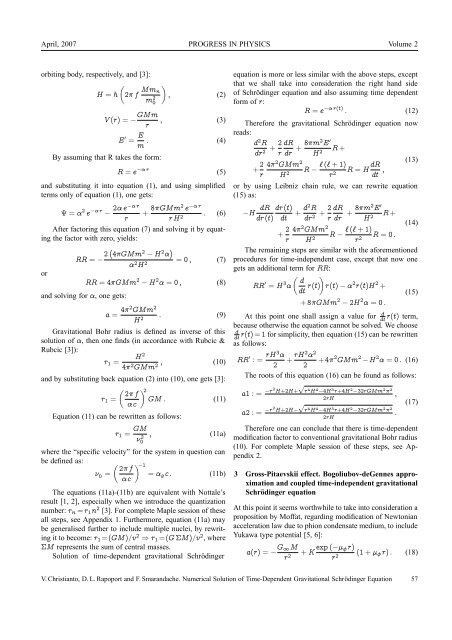ISSUE 2007 VOLUME 2 - The World of Mathematical Equations
ISSUE 2007 VOLUME 2 - The World of Mathematical Equations
ISSUE 2007 VOLUME 2 - The World of Mathematical Equations
Create successful ePaper yourself
Turn your PDF publications into a flip-book with our unique Google optimized e-Paper software.
April, <strong>2007</strong> PROGRESS IN PHYSICS Volume 2<br />
orbiting body, respectively, and [3]:<br />
�<br />
H = h 2π f Mmn<br />
m2 �<br />
, (2)<br />
0<br />
V (r) = − GMm<br />
r<br />
By assuming that R takes the form:<br />
, (3)<br />
E ′ = E<br />
. (4)<br />
m<br />
−α r<br />
R = e<br />
and substituting it into equation (1), and using simplified<br />
terms only <strong>of</strong> equation (1), one gets:<br />
Ψ = α 2 e −α r r 2α e−α<br />
−<br />
r<br />
(5)<br />
+ 8πGMm2 −α r e<br />
r H2 . (6)<br />
After factoring this equation (7) and solving it by equating<br />
the factor with zero, yields:<br />
RR = − 2 � 4πGMm 2 − H 2 α �<br />
α 2 H 2 = 0 , (7)<br />
or<br />
RR = 4πGMm 2 − H 2 α = 0 , (8)<br />
and solving for α, one gets:<br />
a = 4π2 GMm 2<br />
H 2 . (9)<br />
Gravitational Bohr radius is defined as inverse <strong>of</strong> this<br />
solution <strong>of</strong> α, then one finds (in accordance with Rubcic &<br />
Rubcic [3]):<br />
r1 =<br />
H2 4π2 , (10)<br />
GMm2 and by substituting back equation (2) into (10), one gets [3]:<br />
r1 =<br />
� 2π f<br />
αc<br />
Equation (11) can be rewritten as follows:<br />
r1 = GM<br />
ν 2 0<br />
� 2<br />
GM . (11)<br />
, (11a)<br />
where the “specific velocity” for the system in question can<br />
be defined as: � �−1 2π f<br />
ν0 = = αg c .<br />
αc<br />
(11b)<br />
<strong>The</strong> equations (11a)-(11b) are equivalent with Nottale’s<br />
result [1, 2], especially when we introduce the quantization<br />
number: rn = r1n 2 [3]. For complete Maple session <strong>of</strong> these<br />
all steps, see Appendix 1. Furthermore, equation (11a) may<br />
be generalised further to include multiple nuclei, by rewriting<br />
it to become: r1 =(GM)/v 2 ⇒ r1 =(G ΣM)/v 2 , where<br />
ΣM represents the sum <strong>of</strong> central masses.<br />
Solution <strong>of</strong> time-dependent gravitational Schrödinger<br />
equation is more or less similar with the above steps, except<br />
that we shall take into consideration the right hand side<br />
<strong>of</strong> Schrödinger equation and also assuming time dependent<br />
form <strong>of</strong> r:<br />
R = e −α r(t) . (12)<br />
<strong>The</strong>refore the gravitational Schrödinger equation now<br />
reads:<br />
d2R 2 dR<br />
+<br />
dr2 r dr + 8πm2E ′<br />
H2 R +<br />
+ 2 4π<br />
r<br />
2GMm2 H2 ℓ (ℓ + 1)<br />
R −<br />
r2 dR<br />
R = H<br />
dt ,<br />
(13)<br />
or by using Leibniz chain rule, we can rewrite equation<br />
(15) as:<br />
−H dR dr (t)<br />
dr (t) dt + d2R 2 dR<br />
+<br />
dr2 r dr + 8πm2E ′<br />
H2 R +<br />
+ 2 4π<br />
r<br />
2GMm2 H2 ℓ (ℓ + 1)<br />
R −<br />
r2 (14)<br />
R = 0 .<br />
<strong>The</strong> remaining steps are similar with the aforementioned<br />
procedures for time-independent case, except that now one<br />
gets an additional term for RR:<br />
RR ′ = H 3 �<br />
d<br />
α<br />
dt r(t)<br />
�<br />
r(t) − α 2 r(t)H 2 +<br />
(15)<br />
+ 8πGMm 2 − 2H 2 α = 0 .<br />
At this point one shall assign a value for d<br />
dt r(t) term,<br />
because otherwise the equation cannot be solved. We choose<br />
d<br />
dt r(t) = 1 for simplicity, then equation (15) can be rewritten<br />
as follows:<br />
RR ′ : = rH3 α<br />
2 + rH2 α 2<br />
2 +4π2 GMm 2 −H 2 α = 0 . (16)<br />
<strong>The</strong> roots <strong>of</strong> this equation (16) can be found as follows:<br />
a1 : = −r2 H+2H+<br />
a2 : = −r2 H+2H−<br />
√ r 4 H 4 −4H 3 r+4H 2 −32rGMm 2 π 2<br />
2rH<br />
√<br />
r4H 4−4H 3r+4H2−32rGMm2π 2<br />
2rH<br />
,<br />
.<br />
(17)<br />
<strong>The</strong>refore one can conclude that there is time-dependent<br />
modification factor to conventional gravitational Bohr radius<br />
(10). For complete Maple session <strong>of</strong> these steps, see Appendix<br />
2.<br />
3 Gross-Pitaevskii effect. Bogoliubov-deGennes approximation<br />
and coupled time-independent gravitational<br />
Schrödinger equation<br />
At this point it seems worthwhile to take into consideration a<br />
proposition by M<strong>of</strong>fat, regarding modification <strong>of</strong> Newtonian<br />
acceleration law due to phion condensate medium, to include<br />
Yukawa type potential [5, 6]:<br />
a(r) = − G∞ M<br />
r 2<br />
+ K exp (−μφ r)<br />
r 2 (1 + μφ r) . (18)<br />
V. Christianto, D. L. Rapoport and F. Smarandache. Numerical Solution <strong>of</strong> Time-Dependent Gravitational Schrödinger Equation 57

















